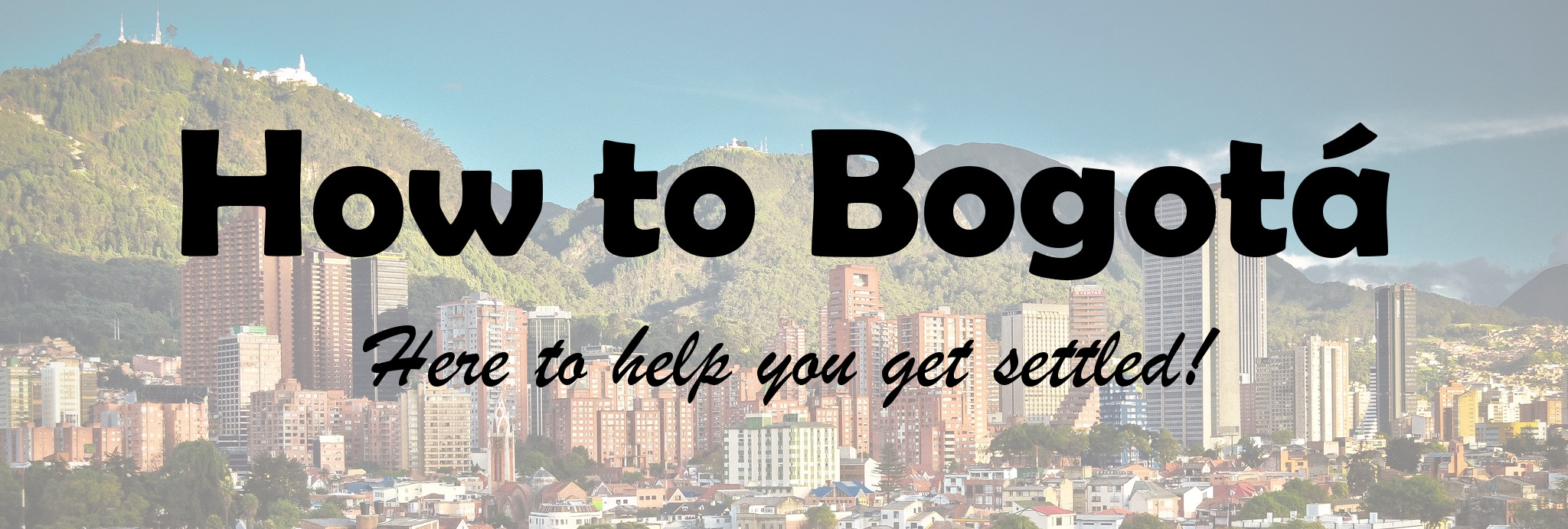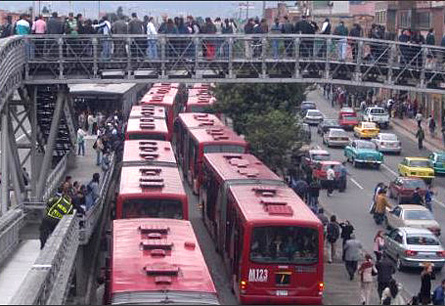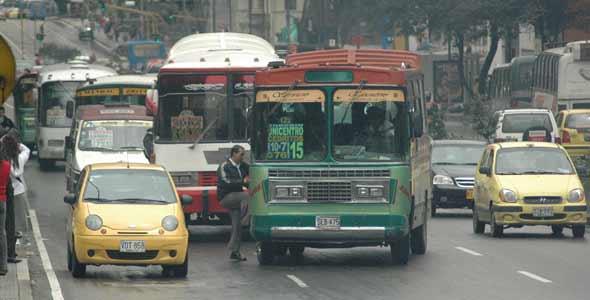Public Transport in Bogotá
Some might say that public transport in Bogotá pales in comparison to Medellín. Bogotá does not have an underground (or overground) metro system, as do many other world (and, indeed, Latin American) capitals. Furthermore, the city operates a system of Pico y Placa, which was introduced as an attempt to reduce congestion. Cars whose number plates end in an even number can drive on certain days of the week, and those with odd numbers can drive on the other days. (In practice, what happens is that those families who can afford it own two cars (an odd and an even) and thus are still able to drive everyday – so the traffic is still bumper-to-bumper every rush hour).
In any case, here are your travel options:
Transmilenio
The Transmilenio is a bus system which has its own lanes in the road which the other traffic is not able to use, and has limited routes through the city. It is the best and safest way of travelling around the city, costing $1400 pesos off-peak and $1700 peak (45p/70cents – 60p-85cents), but be warned, the platforms and buses are often packed to the extent that some bus stations regularly have long queues of people outside trying to get into the station. I regularly find myself standing for an hour on the Transmilenio, because there are rarely seats available. The stations are poorly designed, as platforms will have three or four buses all stopping at the same place in the station, so people waiting for different buses will crowd around the platform doors, and when they open there is a great deal of pushing and shoving (everyone for himself). This is the best that Bogotá has to offer in the form of public transport. Have a look here for more information on how to use the Transmilenio.
Buseta
The busetas are small privately-owned buses, costing the same as a journey on the Transmilenio, which emit disgusting coloured exhaust fumes, are usually driven by maniacs with no regard for road or passenger safety, and are notorious hang-outs for muggers, who will jump on, mug, and jump off. These buses do not have numbers – destinations are displayed on a sign in the front window of the bus, so you have to squint as every bus approaches to try to see if its going in the direction you’re going, and then hail it down wherever you happen to be (there are no bus-stops). The price of a journey varies between 1400 – 1650 pesos, and you pay the driver when you board. When you want to get off, walk to the door at the back of the bus (or the front if there’s only one door), push the button, and the bus driver will stop. I recommend that you sit or stand towards the front of the bus, as muggers will often sit at the back, push the button to get off, and then mug people as the bus is stopping before jumping off the bus.
SITP buses
These are the blue public buses which are much safer than the busetas and only stop at designated bus-stops. Most of these buses have numbers and display the various places they stop at on the front of the bus. To use these buses, you need a tu llave card, which functions like an Oyster card, if you’re familiar with the public transport system in London. You can buy one of these cards from a Transmilenio station, or any shop which displays the sign tu llave. You need to top it up, and then touch it on the card reader when you board an SITP bus. The good thing about the tu llave cards is that as long as you have a positive balance, even if it’s not enough for a journey, you can still use it; it will go into a negative balance if necessary, and remind you to top up your card. If your balance is already negative though, you won’t be able to use it.
Taxi
The final transport option is taking a taxi, and due to various incidents involving dodgy taxi drivers, it’s recommended that you always call for a cab when you need one, instead of hailing one off the street. By European standards, taxis are cheap, with a minimum fare of £1.20; a 20-minute journey across the city would normally cost around 12,000 pesos (£4). However, this is not necessarily a quicker option, as you still have the problems of traffic congestion which can affect various roads at all times of day; during rush-hour, it would probably be quicker to walk somewhere than taking a taxi. For guidance on how to order a taxi using a mobile app, have a look at this post.
What would make a huge difference to the quality of life of Bogotanos would be the introduction of a metro system, such as that which exists in Medellin; large stations, spacious platforms and trains, and a little bit of passenger etiquette when boarding and disembarking. It would ease the pressure on the roads, making those journeys less draining, and would allow people to travel more easily and quickly through the city. People would be spending less time travelling each day, and have more time for activities that they enjoy (or even just more time to relax). Bogotá’s problem is that the money for such projects just seems to disappear into the pockets of politicians and their acquaintances; corruption is the great obstacle which is preventing Bogotá from being able to offer its people a 21st century public transport system. People are ashamed of this, and of the poor conditions of the roads themselves, which are full of cracks and holes – anyone can see that the cheapest materials have been used to pave the roads, which are not fit for purpose. Bogotá needs tarmac, not bricks or huge slates which crack under the pressure of the Transmilenio! Road and pavement maintenance just doesn’t seem to exist.
If those in charge of Bogotá would prioritise town planning, road maintenance, and the public transport system, quality of life would be improved for all Bogotanos, because these things affect everyone on a daily basis.








Leave a comment